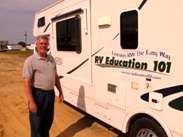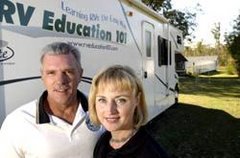Forty thousand people in the United States die each year on the road! With the peak RV travel season here I thought this would be a good time to discuss getting to your RV travel destination safely. Getting there can be half the fun, as the saying goes, if you take a few precautions to make your trip safe.
If you will be traveling over the 4th of July holiday keep safety in mind. In a study a while back these dates, ranked in order, were identified as the 10 deadliest days of the year to drive.
Mark these on your calendar and if possible try to stay put on these dates. One more day at the campground or getting to your destination one day later can’t hurt you, but driving on these dates could do much worse. As you can see most of the dates are close to, or on a major holiday. The article mentioned that the reason for the August dates is because August is the busiest traveled month of the year.
1. July 4
2. July 3
3. December 23
4. August 3
5. January 1
6. August 6
7. August 4
8. August 12
9. July 2
10. September 2
The first step is to plan the trip you are taking. Travel guides, magazines, state tourism boards and Internet sites offer valuable information to help you plan your trip. Route your trip on a map or from an Internet trip planning site. Always keep an atlas or maps in the RV or tow vehicle. Driving a motor home or pulling a trailer can be stressful, especially if you don’t know the route you will be traveling. Using a GPS system can make traveling much less stressful.
Complete a “Pre-Trip Checklist” before you head out on the road. Simple checks like checking your tires, lights, hitch work and other items all contribute to a safer trip. You should make these checks everyday before traveling.
Take plenty of breaks when you’re traveling. Stopping, stretching out and taking brief walks can revitalize you. Do not rush to get to your vacation destination. Driving too fast and for long periods of time can result in fatigue and falling asleep at the wheel. If you feel tired you should pull over and rest or change drivers. It’s a good idea to switch drivers every few hours. Keep a window cracked open to help you stay alert, and only eat light meals when you stop to eat.
Avoid driving or pulling your RV during bad weather and in high winds. Because of the size and mass of RV’s it can be extremely dangerous to travel during periods of high winds. It’s better to get to your destination one day later, than to risk traveling in bad weather.
Limit your driving time to 5 or 6 hours a day (300 to 350 miles). Not only will you be more alert, but you will arrive at the campground with plenty of day light to get set up and settled in before it gets dark outside. This gives you a chance to unwind and get rested for another day of travel, and to enjoy some of the amenities the campground has to offer.
Drive defensively! Stay alert and monitor what is going on around you at all times. Use your mirrors. If you are pulling a trailer it may be necessary to add mirror extensions so you can see along the sides of the trailer.
Always leave plenty of room between you and the vehicle in front of you. RV’s are much heavier than your automobile and require a longer braking distance to come to a stop. This alone will prevent accidents, especially during emergency braking. Driving at a safe speed also lowers your braking distance. Always use a supplemental braking system on the vehicle you are towing too.
Cell phones are nice to have for emergencies, but they can distract the driver. Do not use a cell phone if you are driving. If you must make a call, have someone that is not driving do it for you.
Never drink and drive!
Plan your trip, travel safe and smart and enjoy your RV experiences. Remember, getting there is half the fun!
Happy RV Learning,
Mark Polk
RV Education 101
RV University
RV Orientation
Go for the RV Gold
Follow us on FACEBOOK
RV Consumer
Subscribe to:
Post Comments (Atom)







No comments:
Post a Comment